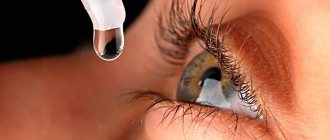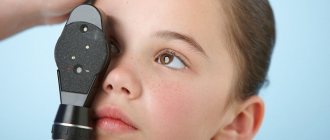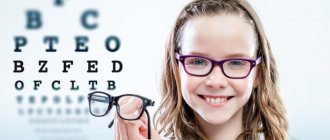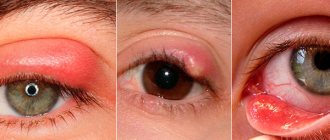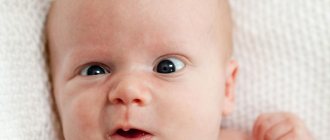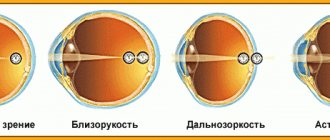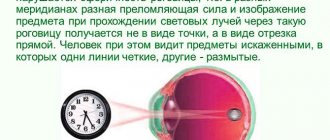Every newborn child perceives the world through sight, touch, hearing, smell, and taste. Unfortunately, nature does not favor all children, and sometimes children are born with some kind of pathology.
Children with visual impairments see the world completely differently, and their development and upbringing require special features. Correctly selected upbringing is very important, since such a child will need to adapt to kindergarten, school, and also in life, which will not be easy. What do parents need to know about the development of children with vision problems?
Features of development and learning for children
Young children who do not see, get acquainted with the world in most cases through hearing and touch. Because of this, their idea of the world is different from the children who see it. Unlike sighted children, blind children have to recognize everything by sound, because of this, one of the most important aspects of education is focusing on sounds. For such children, the participation of specialist doctors is a necessary part of education. It is difficult for children with vision problems to cope without the help of a speech therapist, since in most cases the child is not able to understand words, especially if he does not see real objects.
For such children, they need outdoor games that will stimulate their vision, develop proper movement associated with coordination, and most importantly, learn the necessary skills. All these recommendations can be obtained from an ophthalmologist, who will tell you which games and exercises are suitable for the child. This way you are more likely to succeed.
You may be interested: Red circles under the eyes of a child
— Teach your child proper orientation and coordination. It is advisable to repeat the exercise and actions several times until you reach automaticity.
- Buy toys that are not the same as for ordinary children, but take large ones so that you can feel them well and won’t get hurt. After all, for such children the main thing is to touch everything and learn new things.
— Do not buy toys with small and very sharp parts, so that the child does not injure himself. After all, we can see everything, but they cannot.
— Be sure to teach correct orientation in space, to do this, perform certain tasks and exercises. It is important to explain to the child what he is doing and why.
Choosing a kindergarten
The most responsible should be the choice of kindergarten; when choosing a kindergarten, look at specialized kindergartens for children with visual impairments, organization and implementation of therapeutic purposes to restore vision, and preparation for school. In order to get into a specialized kindergarten, you need to take a referral from your local pediatrician, or from the ophthalmologist with whom you are registered, and go to the psychological-medical-pedagogical commission, which will issue a verdict on visiting a specialized kindergarten.
For a child with visual impairments, such a kindergarten will be the most suitable option, since in such kindergartens there are fewer children in groups than in ordinary kindergartens, in a regular kindergarten there are about 30 people, and in specialized ones there are 6-15 people. And because of this, your child will receive much more attention, and the child will learn exactly what he needs. There are very few disadvantages in such kindergartens, the fact is that such kindergartens are rare, and there are few of them; you have to take the child early in the morning. An equally responsible choice is in educators who must have two degrees, medical and pedagogical. There should be consultations with doctors, an ophthalmologist, a speech therapist, and a psychologist in the kindergarten. Even if you go to a regular kindergarten, the children will most likely laugh at such a child, but not in a specialized kindergarten, since almost all the children there are like that.
You may be interested in: Health benefits of fish oil
Adaptation of children with visual impairments
Adaptation in children with poor vision is slightly worse than in children with normal vision. Because the situation and people change, and the parents who were always with the child all the time are no longer present. The most important thing for parents is not to panic; the child feels it and begins to get nervous.
- Go to the kindergarten together, let the child adapt a little, touch the toys, get to know the teachers and nannies.
— On the first day, bring your baby to the kindergarten for ten twenty minutes, stand near the office and wait, if the child cries and cannot calm down, take him home so that there is no psychological trauma. If everything is fine and he plays, you can wait until he plays enough.
- The second time, leave it for longer, about a couple of hours, even if the child cries, let him get used to it a little. And so on for a couple of hours and you will get used to it. The main thing for such a child is a schedule so that he has an idea of how the day is going and automatically does everything.
Ophthalmological unit
- Correctional and pedagogical work on the development of visual perception in children with visual impairments
- Performance indicators of MBDOU "Kindergarten of compensatory type No. 2"
Ophthalmologist: Avdeeva Natalya Vladimirovna
The staff of the kindergarten's medical office includes an ophthalmologist and a nurse certified in the specialties “Nursing in Ophthalmology” and “Physiotherapy”.
Children with various types of amblyopia, strabismus, congenital pathologies such as partial atrophy of the optic nerves, nystagmus, congenital myopia, congenital cataracts, glaucoma, etc. are subject to referral to kindergarten. Children who need surgical correction of strabismus are sent to the children's department of the regional eye hospital followed by a return to the garden for further treatment.
The ophthalmology office is equipped with all the necessary diagnostic and treatment equipment; there is a “dark room” for skiascopy and light exposure.
Medical and ophthalmological selection and recruitment of groups is carried out by an ophthalmologist from the MBDOU in the direction of ophthalmologists from district clinics and vision care centers. Children are directly treated by a nurse, according to the instructions and under the regular supervision of an ophthalmologist.
The effectiveness of treatment of strabismus and amblyopia in specialized preschool institutions is higher than in eye clinics and vision care offices. Firstly, the child’s normal routine of life is not disrupted, and secondly, it is possible to carry out frequent and lengthy procedures, general health measures, as well as a full range of correctional and pedagogical measures.
The treatment process is based on the use of advanced methods and follows the main principle - an individual approach to the treatment of each child. The therapeutic and pedagogical processes do not exist so much in parallel, but rather penetrate one into the other.
Material and technical equipment of the ophthalmology office
1. Slit lamp 2. Large non-reflex ophthalmoscope 3. Synoptophore 4. Forbis apparatus 5. AMO-ATOS apparatus with the Amblio-1 attachment 6. Cascade attachment for the AMO-ATOS apparatus 7. Rucheyek apparatus 8. Electric ophthalmoscope 9. Set of skiascopic rulers 10. Set of trial spectacle lenses with frames 11. Color test 12. Handheld mirror ophthalmoscope 13. Maculostimulator “Illusion” 14. Set of glasses for accommodation training 15. Tabletop perimeter 16. Roth apparatus - table illuminator for determination of visual acuity 17. Computer complex with headphones 2 pcs. 18. Computer games: Blade, Flower, Lapwing, Ai, Shooting Range, Crosses, Spider, Relax 19. “Ruby” attachment for the AMO-ATOS device 20. Electrical stimulator ESOM
Comprehensive treatment of children with amblyopia includes: pleoptic methods, organization of the children’s life regimen taking into account visual stress, treatment of concomitant diseases, and general health measures. Visual loads are developed for each age category of children, taking into account the nature of fixation, type of strabismus, visual acuity (7 in total).
Among the pleoptic methods, we use direct occlusion, illumination of the posterior pole of the eye on a large non-reflex ophthalmoscope, the treatment method with frequency-contrast stimuli on the Illusion device, light-color stimulation on the AMO-ATOS device with the AMBLIO attachment, magnetic therapy, magnetophoresis with drugs, laser stimulation, electrical stimulation.
The effectiveness of direct occlusion increases significantly if it is combined with visual load of the amblyopic eye (reading a book, drawing, small work, sorting cereals, stringing beads, mosaics, construction sets). This is successfully carried out by teachers in groups and a typhology teacher.
One of the types of pleoptic treatment is gaming computer programs such as Ai, Crosses, Shooting Range, Ice, Spider, Flower, Blade. Treatment on a computer is one of the most favorite methods for children, with the help of which they develop thinking and intelligence, improve hand motor skills, spatial perception, reaction speed, and improve the discriminative ability of the retina.
The combination of computer methods with music therapy significantly improves the quality of treatment.
Orthoptic exercises to restore the symmetrical position of the eyes are carried out using a synoptophore and using computer programs Ai, Blade in red and blue glasses. Diploptic exercises are carried out using the Forbis device using the method of dissociating accommodation and convergence and combining this method with stimulation of the eyes by the speckle structure of laser radiation (laser diploptic).
Restoration of stereoscopic vision is carried out at the final stage of strabismus treatment using the Chibis computer program.
Other treatment methods include accommodation and convergence training using Rucheek devices, the CASCADE attachment to the AMO-ATOS device, accommodation training using the Avetisov-Matz method, which is especially important in the treatment of myopia, accommodation spasm, and divergent strabismus.
The duration of the treatment course is 2-3 weeks, courses are carried out alternately for each group. The child must be examined at the beginning and at the end of each course of treatment, if necessary and during training, visual acuity and the angle of strabismus are assessed. Children before and after surgery on the eye muscles are given courses of treatment on an individual basis. After completing treatment in the office, home treatment is prescribed to consolidate the results. Depending on age and indications, we recommend: gymnastics for horizontal muscles, convergence training, reading with an obstacle (grid), ball games, badminton, volleyball, table tennis, etc.
When children reach 7 years of age and enter school, they are transferred for observation and treatment to an office or vision care center. According to indications, some patients are admitted for further education and treatment to a special boarding school No. 3 for the visually impaired.
Performance indicators for 2019-2020
| Year | Children treated | Number of procedures |
| 2019 | 67 | 16496 |
| 2020 | 94 | 24878 |
Hardware treatment statistics
| Devices | 2011 | 2012 |
| Maculostimulator "Illusion" | 990 | 1140 |
| Synoptophore | 2070 | 2280 |
| "Forbis" - CANCER | 1020 | 1160 |
| "Stream" | 495 | 1000 |
| Computer pleoptics – programs “Blade”, “Flower”, “Shooting Range”, “Cross”, “Ice” | 2090 | 7320 |
| Computer orthopto-diploptics – “Blade” program | 1845 | 4360 |
| Accommodation training | 420 | 260 |
| Electrostimulator "DENAS" | 540 | 255 |
| "Cascade" | 2790 | 4020 |
| Bivisiotrainer | 405 | 60 |
| AMO-ATOS + AMBLYO | 1970 | 2720 |
| Total procedures | 14635 | 24575 |
